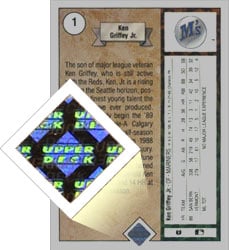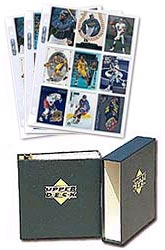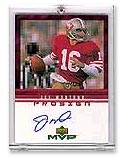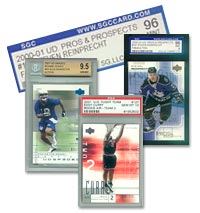The trading card industry has all types. Some collect purely for the joy and hobby of it. They collect the entire set, their favorite players, or their favorite teams. Others speculate purely on the monetary value potential of cards and how to most effectively sell their cards. Others do a little bit of everything- they enjoy collecting and holding onto some of their cards while moving others that they don’t think they want, that they can make money off of, or that someone else would enjoy more. Choose your own path, but if you collect for the pure enjoyment of it, then you are less likely to be disappointed if the value of your favorite player goes down, because you chose to collect the player because you liked him/her in the first place and not how much his/her cards were worth.
How do I know what my cards are worth?
An immediate question asked by many collectors is what their cards are worth. The worth of a card can be defined by a collector in several ways. First of all, it can be measured in terms of personal or sentimental value- the card may be deemed important because it is the collector’s first card or the card features the collector’s favorite player. Still, the most common determinant of a card’s worth centers around financial value.

You can get a sense of a card’s worth before picking up any of these publications or going to an internet auction site. Ask yourself the following questions: Does the card feature a popular player? Is the card an insert-set card? How rare is the card? Does the card contain a piece of memorabilia? Is it autographed? What is the condition of the card? All of these are primary factors in determining the financial value of a card.
Are cards counterfeited? How do I know if the card is real?
An unfortunate aspect of the trading card industry is when some try to make a quick buck by cheating the system. This is especially true when it comes to printing of counterfeit cards that closely resemble the real cards. Where there is a will to make money, even if it is illegal, then there is a way.

The Upper Deck Company was founded on the principle that cards will have a trademarked security hologram printed on the back to prevent counterfeiting. Other card companies have followed suit over the years and created different ways of guaranteeing that their cards are authentic, as it is extremely important to the authenticity of high value insert cards such as autographs and game used cards.
Still, there are fake cards still being produced and distributed out there today, so before you make a big purchase, have an industry expert like your trusted local hobby store owner or a paid grading service analyze the card for you. The extra time and money you put into it may save you in the long run.
Different pricing for card boxes

Before you think that your local shop owner is trying to give you a raw deal, please make sure that you are sure everything being offered within both boxes is the same. Manufacturers create many different box sizes with varying numbers of packs and contents within the same product line for different customer needs. That box for $29.99 likely has fewer packs and less value content within it. Don’t be afraid to ask your local shop dealer questions about the products and points of differentiation between the boxes. Most likely, they are not trying to give you a bad deal.
What is the most valuable trading card in the world?
The Honus Wagner T-206 card, from the early 1900s, is the most valuable trading card globally, famed for its rarity and historical value. Wagner’s refusal to have his image associated with tobacco sales led to its limited distribution, enhancing its scarcity. Over time, with many similar cards lost or damaged, the Wagner card’s rarity increased, making it highly sought after in the collectibles market. Wayne Gretzky and Bruce McNall initially purchased this card for $451,000 at a Sotheby’s auction. It has since changed hands multiple times, with its value surpassing one million dollars in private sales. Currently, this pristine-condition T-206 Wagner card is owned by a private collector, setting it apart from others due to its unmatched condition and significant market value, making it a unique artifact in sports memorabilia.
Keeping cards safe & in good condition
I’ve started my collection, now how can I protect and store them properly?
Congratulations and thank you for starting a trading card collection. We hope that you will join the many generations of collectors, who have enjoyed collecting cards throughout the years. 
Like most things of value, the better the condition of it, the more attractive and valuable they are. The same is true of trading card collecting. Cards that have bent corners, creases through them, or other issues that prevent them from being classified as “mint condition” (which is perfect) have less value.
Therefore, avoid putting your trading cards in bicycle spokes or playing flipping games to preserve their future value. Additionally, keep them away from sunlight, pockets, and pets to prevent damage. Finally, forgoing rubber bands or paper clips protects the edges, maintaining their condition for trading or selling.

Several companies use the latest technologies to produce supplies that protect your collection. Additionally, explore online or contact your local dealer for numerous options. Finally, select the option that best suits your needs.
What is card grading?
Card grading has been a phenomenon over the last few years. An unbiased company grades the card based on the condition of the card. This allows the owner and prospective owners of the card to get a third party’s opinion of the card. This would prevent any debate over the condition of the card. There are many grading companies in the market but the more recognizable Grading companies include PSA and SGC.

The majority of cards submitted for grading are Rookie cards. The higher grade the card receives, the higher value the card will receive in the market. However, the population report of the graded cards dictates the values of the graded cards. Typical of a supply and demand market, the fewer of the higher values a given card has received, the higher value the card will command on the market. You can find prices of graded cards in publications like Sports Market Report and on online auction sites like Ebay.
Most collectors grade the card with the hopes of receiving a high grade, thus increasing the value of the card. Graded cards are great to have a third party’s opinion to help enhance the sale of the cards. In most cases, if collectors are content with the card and plan to keep it, especially in a 9-pocket sheet, then grading the card isn’t necessary.

